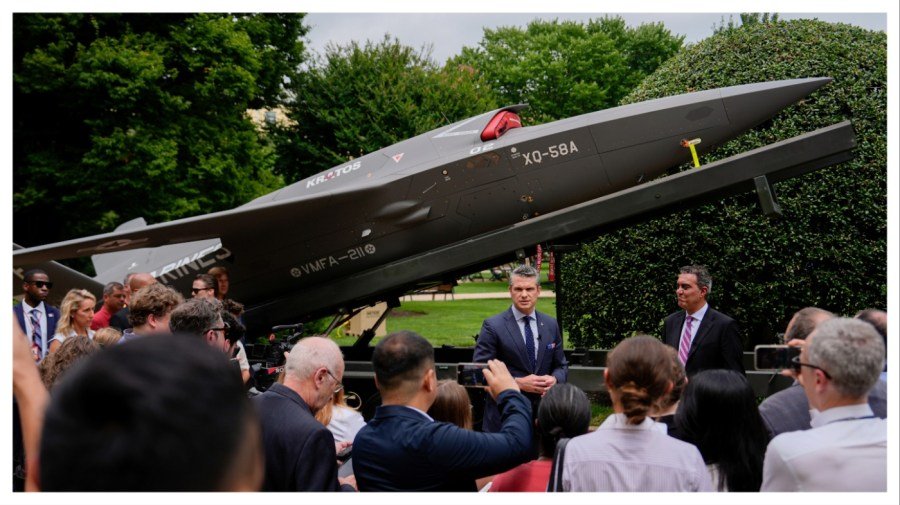
The Trump administration is slashing red tape to quickly equip troops with more small, easily replaced drones in a bid to keep up with the likes of Russia and China, the Pentagon’s chief technology officer told NewsNation’s Kelly Meyer in an exclusive interview.
Emil Michael, the under secretary of Defense for research and engineering, said the U.S. is speedily moving to reduce bureaucratic barriers and expand the quantities and types of drones U.S. troops can use to defend American bases, forces and interests.
“You’ve got to cut the red tape out,” when it comes to drone production, he told Kellie Meyer from The Hill’s sister network. “A lot of the regulations around what you could build and how you could build it, and even how you could test it were limited in the last administration.”
Drones are the new frontline of modern conflicts, featuring prominently in Russia’s war in Ukraine and Israel’s conflicts in the Middle East.
Nowhere were drones displayed so mightily that in June with Ukraine’s Operation Spiderweb, where Kyiv spent months smuggling hundreds of small drones deep inside Russia for coordinated strike that destroyed upwards of 40 Russian warplanes on five airbases.
The operation showed that even far reaching targets were not safe from drone attack, including the United States, a country buffered by two oceans and no significant adversary on its borders.
Case in point, in late 2024 and earlier this year, military bases and sensitive sites struggled to counter swarms of unauthorized drones that flew over them at night, leading to concerns about security and possible spying.
But the United States is currently outpaced by Russia and China in military drone use, a gap caused by a dearth in companies approved to make drones for the U.S. military as well as limited equipment and expertise needed to mass-produce drones, according to a new report released Tuesday by The Heritage Foundation.
Only 14 companies currently can make drones for the Defense Department while just one Chinese company, DJI, accounts for 70 percent of all worldwide drone sales and makes millions of drones each year, putting Washington at a disadvantage. U.S. law bars the military from buying Chinese drones.
“Given its current capabilities, the United States in all probability would not be able to win a drone war with China,” the report states, pointing out that the 20 models and hundreds of copies Washington would be able to deploy today are dwarfed in comparison to Beijing’s millions of unmanned aerial vehicles.
Michael insisted, however, that the United States is not only keeping up in the drone race but also “going for dominance,” pointing to President Trump’s June 6 executive order titled Unleashing American Drone Dominance.”
The order directs federal agencies to fast-track approvals for U.S. drone manufacturers and protect the supply chain from “undue foreign influence.”
That was followed by a series of new policies and investments, announced by Defense Secretary Pete Hegseth last month, to make it easier for defense officials to buy drones and train troops to use them.
“Lethality will not be hindered by self-imposed restrictions, especially when it comes to harnessing technologies we invented but were slow to pursue. Drone technology is advancing so rapidly, our major risk is risk-avoidance,” Hegseth wrote in a July 10 memo. “The department’s bureaucratic gloves are coming off.”
Michael echoed that viewpoint.
“We’re going to have the best technology, we’re going to have mass production, and to do that, we’re going to cut the red tape, and we’re going to let innovation happen in private industry,” Michael said in the interview. “You’re going to see us become dominant, more dominant than we already are in unmanned warfare.”
He did not give a timeline for the U.S. to produce enough drones to meet the Pentagon’s needs – a feat that will take significant investment and time to grow such a domestic industry – but he said that the administration has “invested hundreds of millions of dollars through various programs” for the effort.
“The idea is to have an industrial base that could produce hundreds of thousands of these per month over time, because that’s what we’re seeing out there in the world right now,” he said.
While the United States is adept at developing large, sophisticated and expensive unmanned aircraft such as the Predator and Reaper – both costing tens of millions of dollars each – its industrial base struggles to produce the smaller, inexpensive drones that dominate the conflicts in Ukraine and Middle East and are made with Chinese components.
To fast-track more drones for the U.S. military, Micahel said the Pentagon will now hold two events per year known as the Technology Readiness Experimentation, or T-REX, where manufacturers can demonstrate their drones.
T-Rex, started under the Biden administration’s now defunct Rapid Defense Experimentation Reserve, gives live-fire exercises and prototype demonstrations to help military users assess the technology for real-world use.
“Some of them are just gathering intelligence, or gathering an understanding of what’s happening on the battlefield. Some are carrying weapons. Some are countering other drones,” he said of the range of drones tested. “They could be anything from a few pounds to, you know, a couple 100 pounds, and they could be launched in different ways too. . . . that’s because there’s so many situations that they may have to be used to defend a military base, defend on a battlefield.”
In addition, 18 drone prototypes – all which passed through the T-REX program – are currently under accelerated development at the Pentagon.
The U.S. government also conducted a wargame on how to defend military bases in the United States from drone attacks in March in Alaska.


